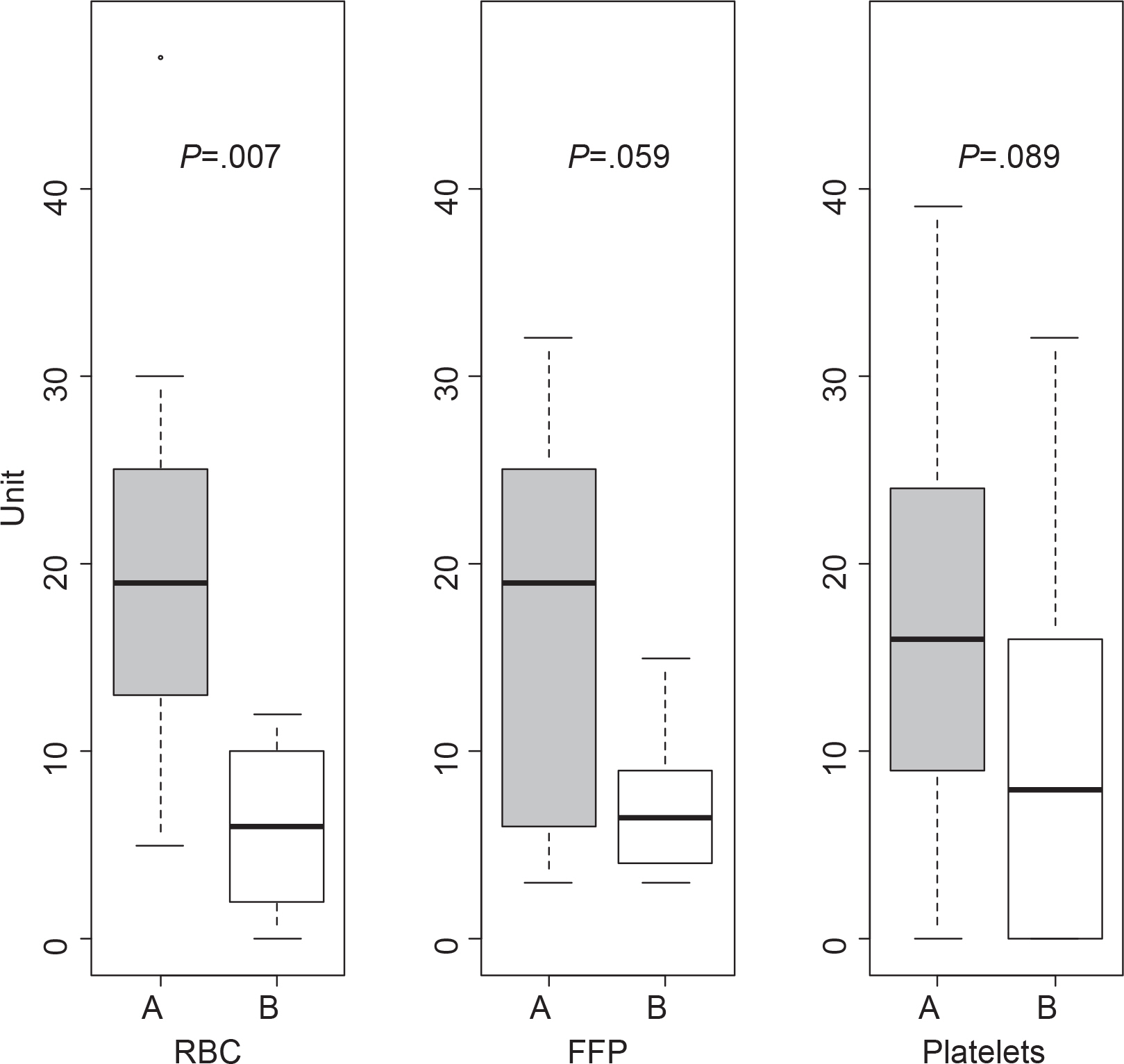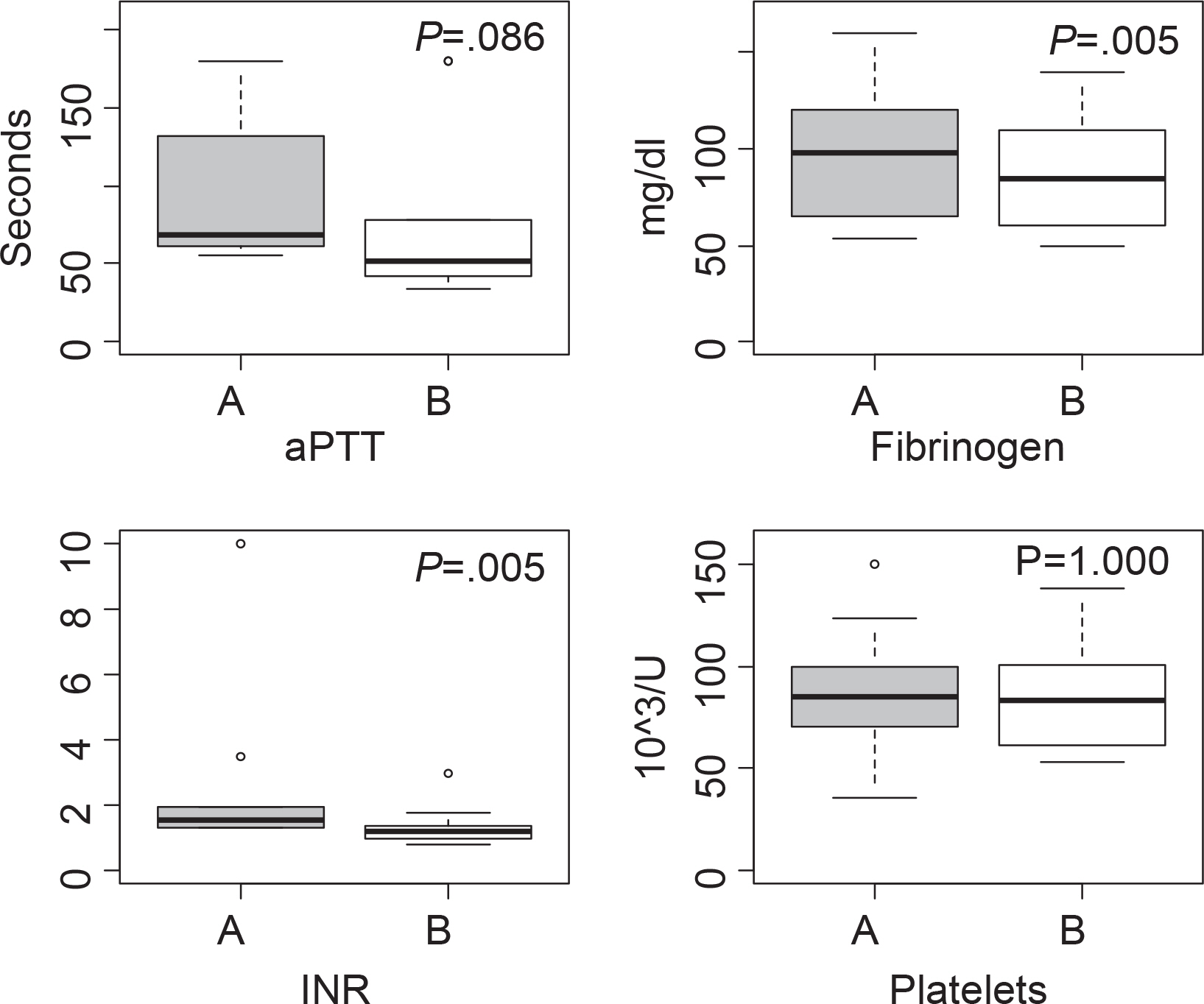Korean J Perinatol.
2013 Mar;24(1):29-36. 10.14734/kjp.2013.24.1.29.
Clinical Efficacy of Recombinant Activated Factor VII in Management of Postpartum Hemorrhage
- Affiliations
-
- 1Department of Obstetrics and Gynecology, Pusan National University School of Medicine, Busan, Korea. ksch0127@naver.com
- KMID: 1427072
- DOI: http://doi.org/10.14734/kjp.2013.24.1.29
Abstract
- PURPOSE
This study was aimed to investigate the clinical efficacy of recombinant activated factor VII (rFVIIa) for patients with intractable postpartum hemorrhage.
METHODS
This was a retrospective study of ten patients who were treated with rFVIIa from July 2010 to February 2012 in one tertiary center. To evaluate each case, we used a standardized case record form. The primary outcome measures were response of rFVIIa, reduction of blood product requirement, changes of coagulation parameter. The response of rFVIIa was categorized to three groups: "complete responder", "partial responder", "poor responder".
RESULTS
After the administration of rFVIIa, effect for bleeding was completely responded in 4 patients, partially responded in 6 patients, and poorly responded in none. A certain amount of reduction in blood product requirements was noted following rFVIIa administration, although no significant differences were observed statistically between before and after rFVIIa administration except RBC (P<0.01). Fibrinogen and INR were significantly reduced in all case types, but other coagulation parameters were not (P<0.01).
CONCLUSION
The present results suggest that rFVIIa is a beneficial therapeutic option that could reduce blood loss and contribute to reduction of maternal morbidities and mortalities in patients with massive postpartum hemorrhage.
MeSH Terms
Figure
Reference
-
1). Lusher JM. Recombinant factor VIIa (Novoseven) in the treatment of internal bleeding in patients with factor VIII and IX inhibitors. Haemostasis. 1996. 26(Suppl 1):124–30.2). Lau P., Ong V., Tan WT., Koh PL., Hartman M. Use of Activated Recombinant Factor VII in Severe Bleeding - Evidence for Efficacy and Safety in Trauma, Postpartum Hemorrhage, Cardiac Surgery, and Gastrointestinal Bleeding. Transfus Med Hemother. 2012. 39:139–50.
Article3). Monroe DM., Hoffman M., Oliver JA., Roberts HR. Platelet activity of high-dose factor VIIa is independent of tissue factor. Br J Haematol. 1997. 99:542–7.
Article4). Hoffman M., Monroe DM., Roberts HR. Activated factor VII activates factors IX and X on the surface of activated platelets: thoughts on the mechanism of action of high-dose activated factor VII. Blood Coagul Fibrinolysis. 1998. 9(Suppl 1):S61–5.5). Mittal S., Watson HG. A critical appraisal of the use of recombinant factor VIIa in acquired bleeding conditions. Br J Haematol. 2006. 133:355–63.
Article6). Kenet G., Walden R., Eldad A., Martinowitz U. Treatment of traumatic bleeding with recombinant factor VIIa. Lancet. 1999. 354:1879.
Article7). Mayer SA., Brun NC., Begtrup K., Broderick J., Davis S., Diringer MN, et al. Recombinant activated factor VII for acute intracerebral hemorrhage. N Engl J Med. 2005. 352:777–85.
Article8). Friederich PW., Henny CP., Messelink EJ., Geerdink MG., Keller T., Kurth KH, et al. Effect of recombinant activated factor VII on perioperative blood loss in patients undergoing retropubic prostatectomy: a doubleblind placebo-controlled randomised trial. Lancet. 2003. 361:201–5.
Article9). Lodge JP., Jonas S., Oussoultzoglou E., Malago M., Jayr C., Cherqui D, et al. Recombinant coagulation factor VIIa in major liver resection: a randomized, placebo-controlled, double-blind clinical trial. Anesthesiology. 2005. 102:269–75.10). Singi SR., Fernandez E., Pandya ST., Badrinath HR. Recombinant factor VIIa: use in fatal post partum hemorrhageIndian experience case series and review of literature. Indian J Hematol Blood Transfus. 2009. 25:1–5.11). Moscardo F., Perez F., de la Rubia J., Balerdi B., Lorenzo JI., Senent ML, et al. Successful treatment of severe intra-abdominal bleeding associated with disseminated intravascular coagulation using recombinant activated factor VII. Br J Hematol. 2001. 114:174–6.12). Haynes J., Laffan M., Plaat F. Use of recombinant activated factor VII in massive obstetric hemorrhage. Int J Obstet Anesth. 2007. 16:40–9.13). Alfirevic Z., Elbourne D., Pavord S., Bolte A., Van Geijn H., Mercier F, et al. Use of recombinant activated factor VII in primary postpartum hemorrhage: the Northern European registry 2000-2004. Obstet Gynecol. 2007. 110:1270–8.
Article14). Ahonen J., Jokela R. Recombinant factor VIIa for life threatening post-partum hemorrhage. Br J Anaesth. 2005. 94:592–5.15). Hossain N., Shansi T., Haider S., Soomro N., Khan NH., Memon GU, et al. Use of recombinant activated factor VII for massive postpartum hemorrhage. Acta Obstet Gynecol Scand. 2007. 86:1200–6.
Article16). Ahonen J., Jokela R., Korttila K. An open non-randomized study of recombinant activated factor VII in major postpartum hemorrhage. Acta Anaesthesiol Scand. 2007. 51:929–36.17). Barillari G., Frigo MG., Casarotto M., Farnia A., Masse B., Wetzl R, et al. Use of recombinant activated factor VII in severe postpartum hemorrhage: data from the Italian Registry: a multicentric observational retrospective study. Thromb Res. 2009. 124:e41–7.18). Franchini M., Lippi G., Franchi M. The use of recombinant activated factor VII in obstetric and gynaecological haemorrhage. BJOG. 2007. 114:8–15.
Article19). McMorrow RC., Ryan SM., Blunnie WP., Bowen M., Carton EG., Gardiner J, et al. Use of recombinant factor VIIa in massive post-partum haemorrhage. Eur J Anaesthesiol. 2008. 25:293–8.
Article20). Phillips LE., McLintock C., Pollock W., Gatt S., Popham P., Jankelowitz G, et al. Recombinant activated factor VII in obstetric hemorrhage: experiences from the Australian and New Zealand Haemostasis Registry. Anesth Analg. 2009. 109:1908–15.
Article21). Tanchev S., Platikanov V., Karadimov D. Administration of recombinant factor VIIa for the management of massive bleeding due to uterine atonia in the post-placental period. Acta Obstet Gynecol Scand. 2005. 84:402–3.
Article22). Kobayashi T., Nakabayashi M., Yoshioka A., Maeda M., Ikenoue T. Recombinant activated factor VII (rFVIIa/NovoSeven) in the management of severe postpartum haemorrhage: initial report of a multicentre case series in Japan. Int J Hematol. 2012. 95:57–63.
Article23). Jan JY., Lin SY., Lin CH., Lee CN., Fan SZ., Han YY. Recombinant activated factor VII as a promising adjuvant therapy for postpartum hemorrhage in the practice of obstetric anesthesia: experience from a university hospital in Taiwan. J Obstet Gynaecol Res. 2011. 37:901–7.
Article24). Welsh A., McLintock C., Gatt S., Somerset D., Popham P., Ogle R. Guidelines for the use of recombinant activated factor VII in massive obstetric haemorrhage. Aust N Z J Obstet Gynaecol. 2008. 48:12–6.
Article25). Klitgaard T., Nielsen TG. Overview of the human pharmacokinetics of recombinant activated factor VII. Br J Clin Pharmacol. 2008. 65:3–11.
Article26). Kessler CM. Antidotes to haemorrhage: recombinant factor VIIa. Best Pract Res Clin Haematol. 2004. 17:183–97.
Article
- Full Text Links
- Actions
-
Cited
- CITED
-
- Close
- Share
- Similar articles
-
- A Case of Successful Treatment of Childhood Intractable Gastrointestinal Hemorrhage with Low Dose Recombinant Activated Factor VII (NovoSeven (R))
- Successful management of maternal factor VII deficiency in a cesarean section
- Clinical Experience with Recombinant Activated Factor VII in a Surgical Patient with Coagulation Factor VII Deficiency: A case report
- A Case of Intractable Gastrointestinal Bleeding during Chemotherapy in Hereditary Coagulation Factor Deficiency
- Orthognathic Surgery in a Patient with Factor VII Deficiency



